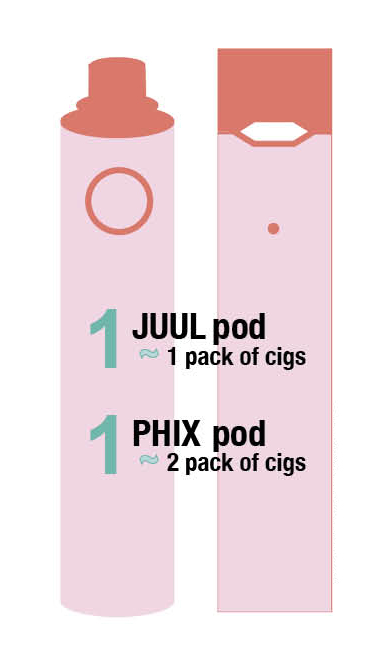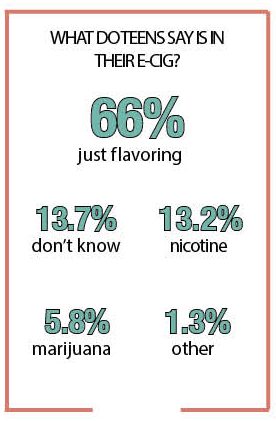Vaping: both sides of the epidemic
July 1, 2018
High schoolers share their opinions on vape pens
Passing the device back and forth, a cloud of mist rises over the group of students huddled in the bathroom, filling the stalls with a fruity scent. Created as an alternative to cigarettes, vaporizers have been on the market for awhile but only recently began to increase in popularity, particularly among teenagers.
Given the wide variety of vaporizers available, there are options created to please everyone, allowing for preference of content, nicotine level, flavor, style, and brand, such as the popular JUUL or PHIX. The range of appearances makes e-cigs harder to identify and easier to hide from adults, adding to the appeal.
‘It’s somewhat ridiculous—I have no problem with people using it, as long as they know what’s going on, I’m not going to try to stop them,” junior Phil Brual said. “But the fact that we have guys in bathrooms doing it to where now the bathroom doesn’t smell only like a nasty restroom but also smells like berries and mint, it’s just a weird combination.”
Students vape all over campus, from the bathroom to classes to behind portables.
“[In one of my classes] we get a break every class period and they talk to each other, they’re like ‘PHIX break? Yeah, yeah’,” senior Zoe Watson said. “They all go together, a group of six people to the bathroom, come back five minutes later. During lunch, you see everyone going through the parking lot, too. As soon as people see a chance they take it.”
According to senior Kieran Barrington, almost all of his friends either vape or have tried it at some point.
“I think it’s popular because it became a trend, so everyone else wants to join in, and I think more people are using it for fun rather than to actually stop smoking,” Barrington said. “I’ve definitely seen many people vape at school especially with JUULs. I don’t really care that others [do], but they are putting themselves at risk of getting caught.”
Watson believes that since it’s considered a safer drug, students are more unconcerned about doing it in public.
“I think people get too comfortable with it, and they don’t realize they really shouldn’t have it on campus,” Watson said. “People sell it on campus, and [Bowie’s] definitely not a place for it. People get a little carried away.”
Students begin vaping for a variety of reasons. Barrington uses three milligrams of nicotine and said he vapes because he likes the cloud effect and finds it entertaining when he is bored.
“I’m aware that nicotine is pretty bad for you but it’s not really gonna stop me because I don’t use it everyday,” Barrington said. “I have gotten nicotine poisoning before and it’s not fun. I stopped vaping a lot and only do it like three times a week so I don’t feel sick anymore.”
Finding it helpful for stress, senior Sheldon Wall also vapes with three milligrams.
“It’s just kind of calming; whenever I get extremely mad, it’s something [where] one hit brings down my nerves a bit and it’s very calming and a little relaxing,” Wall said. “I could literally start and stop, and I wouldn’t have any problems just because I have such a low level [of nicotine]. It just gets what needs to be done, done.”
 Watson initially started vaping in an attempt to get her mom off of smoking and doesn’t use any nicotine.
Watson initially started vaping in an attempt to get her mom off of smoking and doesn’t use any nicotine.
“I guess I see it as better than [smoking], and I don’t really use a strong enough level to feel the addiction and stuff,” Watson said. “I’m a very anxious person, but I don’t have it strong enough to feel any nicotine rush, so it’s nothing like that. It’s really just the comfort of something to do and to not be sitting fidgeting, plus it’s fun to play with the smoke.”
For Watson, not using higher nicotine levels makes the only downside the mess.
“It is kind of a nasty habit, it’s kind of off-putting,” Watson said. “It does get a little gross like it can get messy, the juice is sticky, smelly. I have hit higher ones from friends and it puts you on your [butt], excuse my language. It’s a huge headrush and then you have to sit down.”
Sophomore Angelina Amaral thinks kids who don’t do other drugs are more likely to turn to vaping over more intense drugs.
“I just think it’s a better choice than cigarettes and people like to do tricks with them and stuff,” Amaral said. “I don’t think it’s bad, but I feel like people can overdo it sometimes and they need to give it a break.”
Vaporizers are relatively easy to get a hold of, and freshman Avery Shelton believes this to be a reason why it is popular.
“I know a lot of people do it, I don’t know if all the teachers know,” Shelton said. “I know that it goes on in class and stuff. I think if you’re going to do it, it shouldn’t be at school because some people might not want to be around it.”
Despite it being illegal for students under 18, there are students in all grade levels of high school that vape. From what Brual knows, most begin in the transition between middle school and freshman year.
“I hear a lot of stories about middle schoolers vaping and all that, and most of the time I feel like they’re getting them from an older person, like a brother or sister,” Brual said. “I feel like most people start eighth grade to freshman year because that’s the easiest time to influence somebody, when they’re changing into a new school or changing into a new life.”
Brual believes people should be allowed to make the choices they wish, however they should be courteous and use common sense when it comes to vaping.
“If there’s a kid sitting next to you taking a quiz, you shouldn’t blow a puff into his face,” Brual said. “If someone’s trying to pee, you don’t blow into the back of their neck. If someone doesn’t want it around them, don’t force it upon them; if someone doesn’t want to smell it, don’t do it around them, do it somewhere else.”
Teachers and administration speak on rise of e-cigs
 A sharp increase in the amount of teenagers vaping has caught the attention of the teachers and administrators, who hope to prevent it.
A sharp increase in the amount of teenagers vaping has caught the attention of the teachers and administrators, who hope to prevent it.
Vaping is forbidden on school property, but there are still students who continue to do so on campus.
“We have seen an increase of students who are vaping on campus and that’s concerning because that means they’re not focusing on their academics and focused on their work,” academic dean Susan Leos said. “Students in general know they’re not supposed to be vaping, so that makes them hide behind a corner, go into a bathroom. We want students to be able to come to school to learn and to focus on their academics, their friendships, and their extracurricular activities.”
Due to vaping being a new concern, there is no specific discipline code for it and it is coded the same as cigarettes or tobacco. Currently, students who are caught with vaporizers have the device confiscated, to be returned only to a parent, and assigned a day of In School Suspension.
“It’s become a very, very serious problem here on campus,” assistant principal Lawrence Britton said. “It’s something that we are looking to try to adjust the policies [for], because it’s something that’s new, so we’re looking for central office and the discipline office to maybe adjust the policy to [have] more consequences.”
Administration has procedures in the work to tackle the rise in vaping at school with the help of the Security Resource Officers (SRO).
“What will probably happen is that we will get with the SROs, probably at the beginning of the next school year during the professional development, the first days that teachers get here, and give them just a brief workshop making them aware of what those devices are,” Britton said. “Bowie has a lot of good kids, but there are some habits that we need to make teachers aware of. That’s what we want to do beginning of school next year, make them aware of what those devices are.”
AP Biology teacher Jessica Davis is in favor of having guidelines to follow for dealing with vaping.
“I would love to have something in place,” Davis said. “Hopefully deterrence would be enough for some kids who aren’t really inclined to do particularly bad things, but they don’t think it’s bad so they go ahead and do it. I think if it were really emphasized and there were deterrence in place, those kids might stop.”
There are also plans to get equipment that can distinguish the contents in vape pens. The concern lies not only with nicotine but tetrahydrocannabinol (THC) as well.
“You can quite possibly get THC in it as well,” Britton said. “Students engage in that, and actually, possession of THC is against the law, it’s a violation of the law. We don’t have any way of testing it, but now the SROs are getting the equipment necessary to be able to test it and see if the contents is of THC, which is the stuff in marijuana that gets you high.”
Teachers have already been instructed to keep an eye out for vape pens.
“I’ve heard that a lot of kids, they have this new device that looks like a USB, and it goes in the side of their computer, and that’s really their vaping device and they charge it,” health teacher and softball coach Elizabeth Wissel said. “I know we’ve had kids throughout our campus that are vaping, either behind the portables, in the locker rooms, bathrooms, class. It’s definitely raising a flag of awareness.”
Student leadership teacher and basketball coach Vickie Benson referred to vaping as an “overnight sensation” and aimed to be diligent in figuring out the draws for teenagers interested, as well as the dangers involved.
“My opinion about vaping, is that one, for teenagers under eighteen it’s illegal, it’s not really my opinion it’s just the law,” Benson said. “Two, I think that not enough teenagers understand the actual, real impact of the amount of nicotine that they’re ingesting or that they’re exposing themselves too, as well as the effects that it has on their young, developing brains.”
With vaporizers and e-cigs being marketed as alternatives to smoking, people turn to vaping as something safe to do.
“I think they think it’s not smoke so therefore it’s not bad, but more and more studies are coming out demonstrating that chemicals even in the non-nicotine version are carcinogenic,” Davis said. “They have the ability to modify the epigenome which changes your gene expression pattern, and that can be passed on to your children. I think that they think that it’s harmless and it very much is not.”
The health dangers are made worse when teenagers experiment with the device. In a method called dripping that creates a stronger hit, the liquid is placed directly onto the coils of the vaporizer.
“[Having] the chemicals, [even] outside of the nicotine, inside the cells are dangerous,” Davis said. “Especially in combination with high heat, a lot of them tend to be a lot more reactive, and that’s exactly what happens when [people drip].”
While some students are 18 and can legally vape, Leos still feels that the faculty has a responsibility in addressing the health aspect of vaping for all students.
“I’m not a person who makes choices for adults out there in the world, that’s up to adults to do,” Leos said. “But as a mother and an educator, I think anytime in our health classes and in our science classes that we can promote understanding choices that are out there, students will at least know what they’re getting into or know the options or know the choices.”
Vaping is considered a topic of concern due to the effects it has had throughout the school.
“I know even in health, we have not addressed it up until this year, when we’ve really started talking about it,” Wissel said. “We’re even going to bring it into our curriculum, that’s how much it’s made an impact on our schools. It’s their concern that students do not know all the facts, and they want to bring it to their attention.”
Benson feels that many teenagers are misled to think it is safe, and she also believes they don’t notice the effects on their performance until they get off of it.
“I know one particular person that was doing it, and got caught doing it, and stopped doing it,” Benson said. “And while doing it, was like ‘it’s not a big deal, whatever’, but after not doing it for several weeks, [they realize] how much it really impacted them physically: not wanting to eat, or craving that, or having to have that to function, and [that] having that made them as an athlete less productive, that they’re able to see that now by not doing it.”
it,” Benson said. “And while doing it, was like ‘it’s not a big deal, whatever’, but after not doing it for several weeks, [they realize] how much it really impacted them physically: not wanting to eat, or craving that, or having to have that to function, and [that] having that made them as an athlete less productive, that they’re able to see that now by not doing it.”
The perception of safety, combined with many options of shape, content, and flavors, makes vaping an attractive drug of choice.
“The tobacco companies and companies that market the vape industry, they’re marketing in ways that entice students in,” Leos said. “That’s concerning to me because they’re setting up their product in ways that they know it would be more attractive to students who are not adults. That’s a concern to me, they’re taking advantage of our own kids and students.”
Benson urges students to consider checking with official sources such as JUUL itself or the Food and Drug Administration (FDA) if they want confirmation on health effects, rather than random blogs and YouTube videos.
“I know that even the CEO of the company of JUUL, they are doing research right now, working with the FDA right now on how to limit the accessibility for teenagers,” Benson said. “They claim that that was never their intent, you know everybody knows the intent was to help smokers stop smoking, but smokers want to smoke, they don’t want to vape, so that’s kind of been a bust. Because of the flavoring and all the different things, it’s very appealing to children even, not just teenagers, like 12 and 13 year olds.”
Britton advises that people should not try things until they know the true effects of it.
“I think students have the perception that they’re invincible, that ‘something won’t happen to me’, and that’s really not the case,” Britton said. “It can happen to anyone, if it’s harmful to your body, it can happen to anyone. It’s just that students think that because they’re so young, they’re invincible, and where it catches up to you is later on. There’s too much uncertainty when dealing with e-cigs.”








